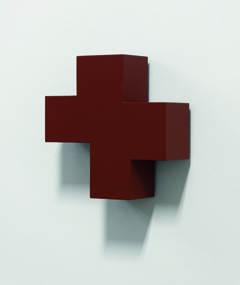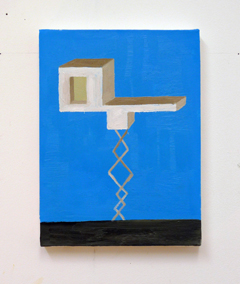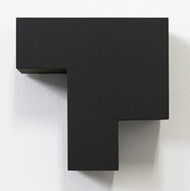Exhibition information
Antje Dorn | François Perrodin
11. April bis 9. August 2014
The exhibition creates a dialogue between Antje Dorn’s new painting series, “Bauten,” and works by François Perrodin. Galerie m is thus venturing an experimental constellation of two very different work complexes that promises viewers some new and surprising perspectives and insights.
The Berlin artist Antje Dorn (b. 1964 in Aachen) avails herself of the creative freedom inherent to painting to develop architectural fantasies in her new series “Bauten”. These whimsical structures defy the logic of gravity and seem to float before a monochrome background, held together as if through a gravitational field. The freely invented architectural complexes made up of cuboid volumes and blocks, swimming pools and observation decks, stairs and ramps, seem in their totality to be quite self-contained and balanced. They are sublimely elevated above the landscape, only tenuously connected to a usually barren rocky crag, or even released from it entirely, giving the impression of weightlessness.
Abstraction and figuration intermingle here. Scattered patches of colors defy definition, alluding to the autonomy of painting, which follows its own laws and does not necessarily have to have an illustrative function. The pictures manifest an experimental handling of perspective. The diverging angles that result, together with their bold hues, lend them an animated feel. The images’ formal reduction and monochrome surfaces furthermore express a specific understanding of the power of symbols to direct our perception and lend meaning.
As in the landscape series “Milkyway,” the absurd turns up here again as a narrative element, when for example ramps rise up as springboards into empty space or individual geometric shapes develop their own independent movement.
The monochrome wall objects by François Perrodin (b. 1956 in Guadeloupe, lives and works in Paris) clearly stand out against the white ground, facing off directly with the viewer. While the works are perceived head-on as painted polygonal, angular surfaces, as soon as the viewer moves through the room, their contours begin to change. “The object remains the same of course, but the way we see it is altered by the context,” is how the artist himself puts it.
The dark, opaque shades of gray, with which green, blue or violet are intermixed, reveal no brushstrokes. They are designed to invite a play of light and shadow across the surfaces corresponding to the shape of the picture support and hence respond to the surrounding space with its particular lighting conditions. At the same time, the matte and uniform layer of paint absorbs the light, making the object appear massive and heavy – just like the individual elements of the work “76.1.” These twelve squares, which differ subtly in size and tonality, are placed on a virtual grid. The regular arrangement and centering on intersection points, as well as the equilibrium of each individual square on its own, stand in apparent contrast to how the whole is perceived by the viewer. Optically, the squares seem to vibrate, conveying a feeling of lightness and movement – a phenomenon that can also be observed when contemplating the works of Antje Dorn. François Perrodin defines criteria for each series with respect to the surface qualities, the proportions, which are based on numerical ratios, and the color values and their interaction. Despite these rational components, however, the perception of his works defies our comprehension. We can only grasp them intuitively, and do so in continually changing ways.
As different as the two artistic approaches on view may be at first glance, it is just as surprising to discover the parallels that are revealed by the juxtaposition of the works of François Perrodin and Antje Dorn. These common threads range from formal considerations to the question of the object and its effect in space. Both bodies of work evoke an interplay between what is rationally verifiable and what can only be sensed intuitively. Perrodin’s objects are based on precise definitions, which can be traced and understood theoretically. However, this condition contradicts how we actually perceive them. While the surfaces and forms at first give an impression of stability and quiet immobility, they soon reveal an openness that manifests itself in constant oscillation. Dorn creates in her intuitive and imaginative fashion architectural images that at first seem to satisfy our expectations of balance and coherence. It doesn’t seem to matter that the structures defy all physic laws.
In both cases, our impressions turn out to be volatile and unstable. Antje Dorn and François Perrodin confront us with the question of what we are seeing and what it actually is.
The exhibition creates a dialogue between Antje Dorn’s new painting series, “Bauten,” and works by François Perrodin. Galerie m is thus venturing an experimental constellation of two very different work complexes that promises viewers some new and surprising perspectives and insights.
The Berlin artist Antje Dorn (b. 1964 in Aachen) avails herself of the creative freedom inherent to painting to develop architectural fantasies in her new series “Bauten”. These whimsical structures defy the logic of gravity and seem to float before a monochrome background, held together as if through a gravitational field. The freely invented architectural complexes made up of cuboid volumes and blocks, swimming pools and observation decks, stairs and ramps, seem in their totality to be quite self-contained and balanced. They are sublimely elevated above the landscape, only tenuously connected to a usually barren rocky crag, or even released from it entirely, giving the impression of weightlessness.
Abstraction and figuration intermingle here. Scattered patches of colors defy definition, alluding to the autonomy of painting, which follows its own laws and does not necessarily have to have an illustrative function. The pictures manifest an experimental handling of perspective. The diverging angles that result, together with their bold hues, lend them an animated feel. The images’ formal reduction and monochrome surfaces furthermore express a specific understanding of the power of symbols to direct our perception and lend meaning.
As in the landscape series “Milkyway,” the absurd turns up here again as a narrative element, when for example ramps rise up as springboards into empty space or individual geometric shapes develop their own independent movement.
The monochrome wall objects by François Perrodin (b. 1956 in Guadeloupe, lives and works in Paris) clearly stand out against the white ground, facing off directly with the viewer. While the works are perceived head-on as painted polygonal, angular surfaces, as soon as the viewer moves through the room, their contours begin to change. “The object remains the same of course, but the way we see it is altered by the context,” is how the artist himself puts it.
The dark, opaque shades of gray, with which green, blue or violet are intermixed, reveal no brushstrokes. They are designed to invite a play of light and shadow across the surfaces corresponding to the shape of the picture support and hence respond to the surrounding space with its particular lighting conditions. At the same time, the matte and uniform layer of paint absorbs the light, making the object appear massive and heavy – just like the individual elements of the work “76.1.” These twelve squares, which differ subtly in size and tonality, are placed on a virtual grid. The regular arrangement and centering on intersection points, as well as the equilibrium of each individual square on its own, stand in apparent contrast to how the whole is perceived by the viewer. Optically, the squares seem to vibrate, conveying a feeling of lightness and movement – a phenomenon that can also be observed when contemplating the works of Antje Dorn. François Perrodin defines criteria for each series with respect to the surface qualities, the proportions, which are based on numerical ratios, and the color values and their interaction. Despite these rational components, however, the perception of his works defies our comprehension. We can only grasp them intuitively, and do so in continually changing ways.
As different as the two artistic approaches on view may be at first glance, it is just as surprising to discover the parallels that are revealed by the juxtaposition of the works of François Perrodin and Antje Dorn. These common threads range from formal considerations to the question of the object and its effect in space. Both bodies of work evoke an interplay between what is rationally verifiable and what can only be sensed intuitively. Perrodin’s objects are based on precise definitions, which can be traced and understood theoretically. However, this condition contradicts how we actually perceive them. While the surfaces and forms at first give an impression of stability and quiet immobility, they soon reveal an openness that manifests itself in constant oscillation. Dorn creates in her intuitive and imaginative fashion architectural images that at first seem to satisfy our expectations of balance and coherence. It doesn’t seem to matter that the structures defy all physic laws.
In both cases, our impressions turn out to be volatile and unstable. Antje Dorn and François Perrodin confront us with the question of what we are seeing and what it actually is.

Antje Dorn
#22 aus der Serie "Bauten", 2014
50 x 40 cm, Öl auf Leinwand
#22 aus der Serie "Bauten", 2014
50 x 40 cm, Öl auf Leinwand

François Perrodin
"74.14", 2013
27 x 27 x 9 cm, Acryl/Holz
"74.14", 2013
27 x 27 x 9 cm, Acryl/Holz

Antje Dorn
#19 aus der Serie "Bauten", 2014
40 x 30 cm, Öl auf Leinwand
#19 aus der Serie "Bauten", 2014
40 x 30 cm, Öl auf Leinwand

François Perrodin
"69.45", 2012
18 x 18 x cm, Acryl/Holz
"69.45", 2012
18 x 18 x cm, Acryl/Holz
